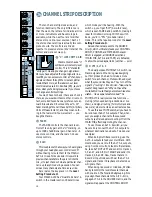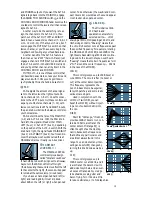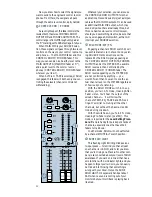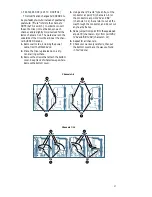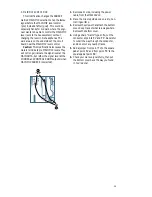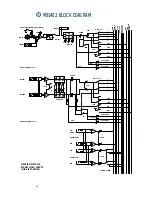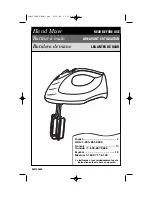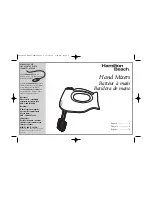
18
U
+15
-15
U
+15
-15
U
+12
-12
HI
12kHz
MID
2.5kHz
LOW
80Hz
EQ
AUX
1
2
MON/
EFX
EFX
PAN
L
R
SOLO
1
MUTE
ALT 3
–
4
dB
30
20
10
O
O
40
50
5
5
U
60
10
U
O
O
+15
U
O
O
+15
CHANNEL STRIP DESCRIPTION
The ten channel strips look alike, and
function identically. The only difference is
that the six on the left are for individual mics
or mono instruments and have more gain
available, while the next four are for either
stereo or mono line-level sources. (Each of
the stereo channel strips is actually two com-
plete circuits. The controls are linked
together to preserve stereo.) We’ll start at the
bottom and work our way up…
“U” LIKE UNITY GAIN
Mackie mixers have a “
U
”
symbol on almost every level
control. This “
U
” stands for
“unity gain,” meaning no change in signal level.
Once you have adjusted the input signal to line-
level , you can set every control at “
U
” and your
signals will travel through the mixer at optimal
levels. What’s more, all the labels on our level
controls are measured in decibels (dB), so you’ll
know what you’re doing level-wise if you choose
to change a control’s settings.
You won’t have to check it here and check it
there, as you would with some other mixers. In
fact, some don’t even have any reference to ac-
tual dB levels at all! Ever seen those “0–10”
fader markings? We call these AUMs (Arbitrary
Units of Measurement), and they mean noth-
ing in the real world. You were smart — you
bought a Mackie.
FADER
The
FADER
controls the channel’s level…
from off to unity gain at the “U” marking, on
up to 10dB of additional gain. Channels 1–6
use mono controls, and channels 7–14 use
stereo controls.
SOLO
This lovable switch allows you to hear signals
through your headphones or control room
without having to route them to the
MAIN
or
ALT 3–4
mixes. Folks use solo in live work to
preview channels before they are let into the
mix, or to just check out what a particular chan-
nel is up to anytime during a session. You can
solo as many channels at a time as you like.
Solo is also the key player in the
Level
Setting Procedure
.
Your MS1402-VLZ has “Dual-Mode Solo.” A
switch in the master section
determines
which mode you’ll be hearing. With the
switch up, you’ll get “SIP” (Solo-In-Place),
which is post-FADER and post-PAN, making it
ideal for mixdown soloing. With the switch
down, you’re in “PFL” (pre-fader listen)
mode. This is the required mode for the
Level
Setting Procedure
.
Soloed channels are sent to the
SOURCE
mix , which ultimately feeds your
CONTROL
ROOM
,
PHONES
and
METERS
. Whenever
SOLO
is engaged, all
SOURCE
selections
(
MAIN MIX
,
ALT 3–4
and
TAPE
) are defeated,
to allow the soloed signal to do just that — solo!
MUTE/ALT 3–4
The dual-purpose
MUTE/ALT 3-4
switch is a
Mackie signature. When Greg was designing
our first product, he had to include a mute
switch for each channel. Mute switches do just
what they sound like they do. They turn off the
signal by “routing” it into oblivion.
“Gee, what a
waste,”
Greg reasoned.
“Why not have the
mute button route the signal somewhere else
useful…like a separate stereo bus?”
So
MUTE/ALT 3-4
really serves two functions —
muting (often used during a mixdown or live
show), and signal routing (for multi-track and
live work) where it acts as an extra stereo bus.
To use this as a
MUTE
switch, all you have to
do is
not
use the
ALT 3–4
outputs. Then, when-
ever you assign a channel to these unused
outputs, you’ll also be disconnecting it from the
MAIN MIX
, effectively muting the channel.
To use this as an
ALT 3–4
switch, all you
have to do is connect the
ALT 3–4
outputs to
whatever destination you desire. Two popular
examples:
When doing multitrack recording, use the
ALT 3–4
outputs to feed your multitrack. With
most decks, you can mult the
ALT 3–4
outputs,
using Y-cords or mults, to feed multiple tracks.
So, take
ALT OUT LEFT
and send it to tracks 1,
3, 5 and 7, and
ALT OUT RIGHT
and send it to
tracks 2, 4, 6 and 8. Now, tracks that are in
Record or Input modes will hear the
ALT 3–4
signals, and tracks in Playback or Safe modes
will ignore them.
When doing live sound or mixdown, it’s often
handy to control the level of several channels
with one knob. That’s called Subgrouping. Sim-
ply assign these channels to the
ALT 3–4
mix,
engage
ALT 3–4
in the
SOURCE
matrix, and the
signals will appear at the
CONTROL ROOM















